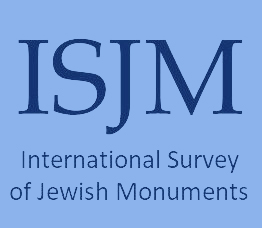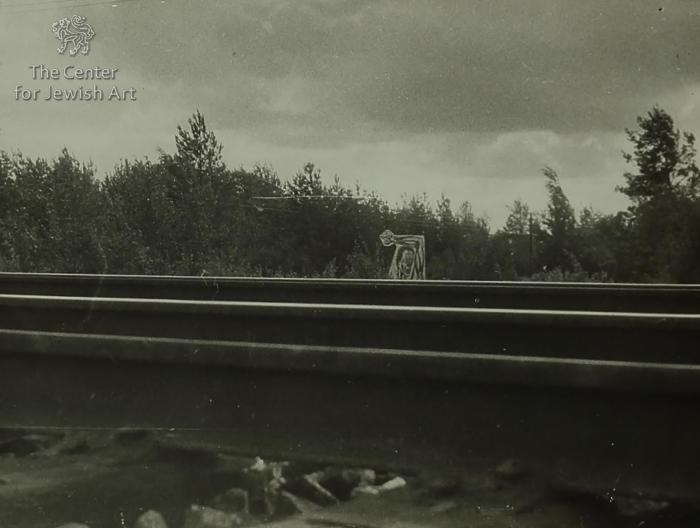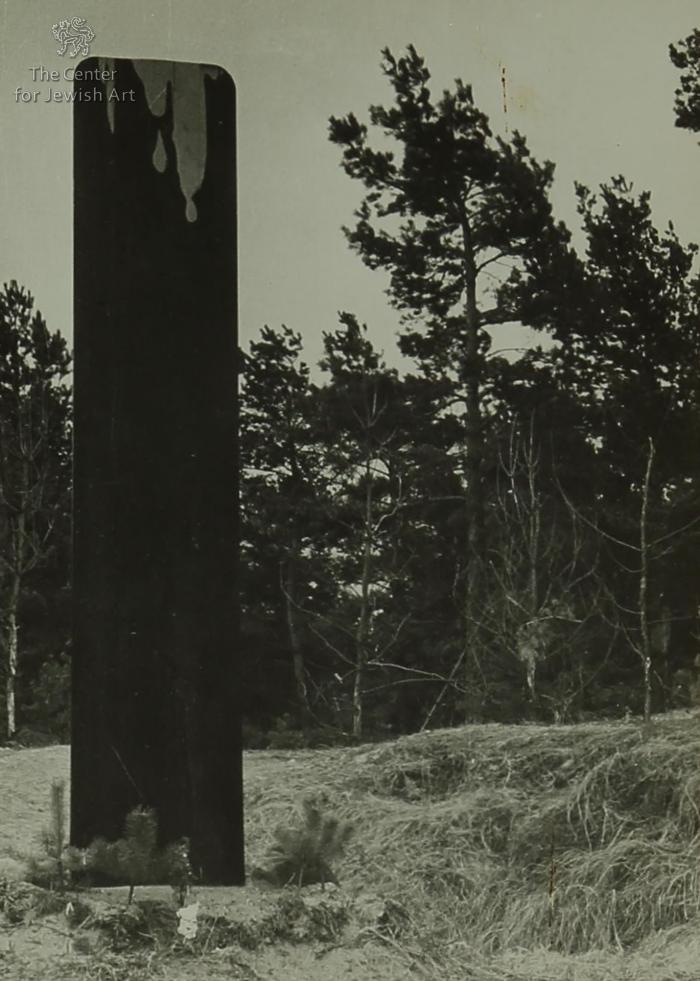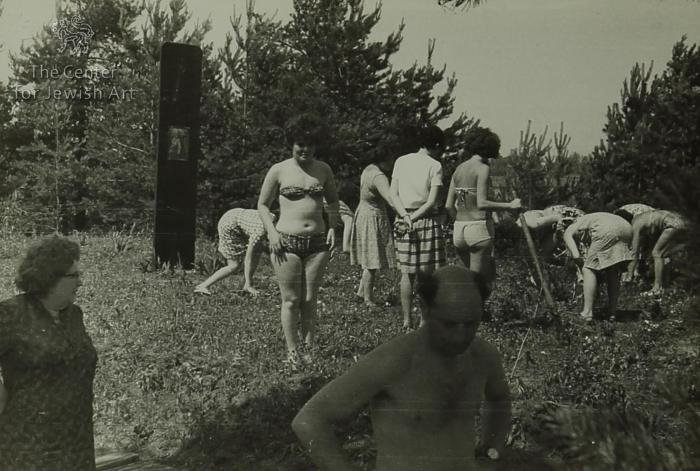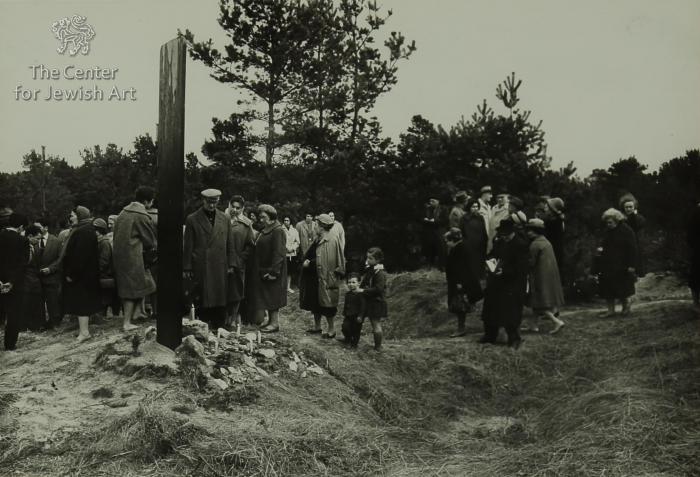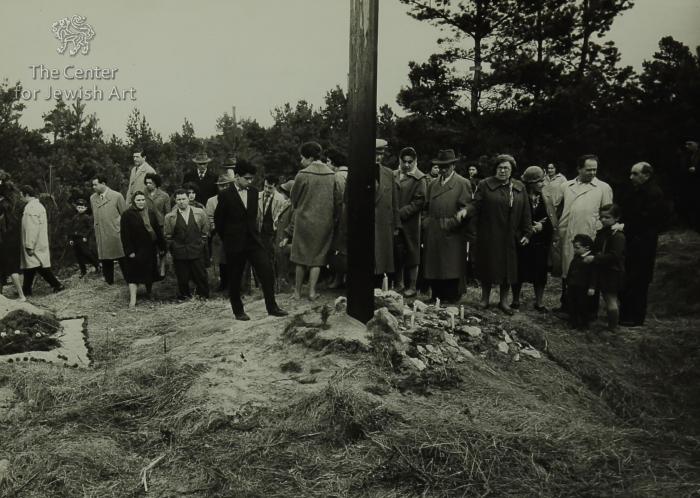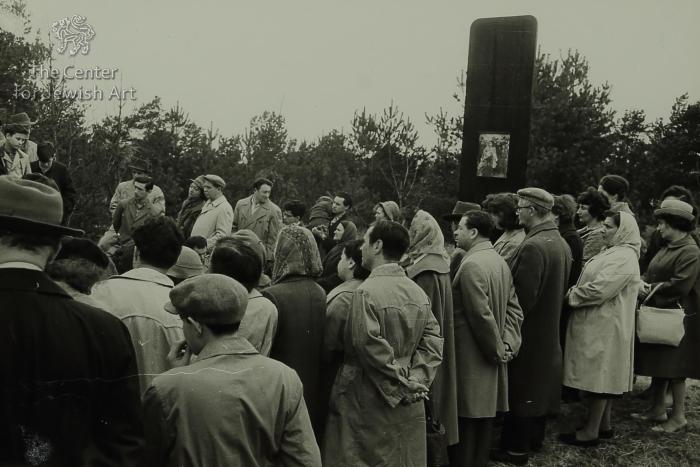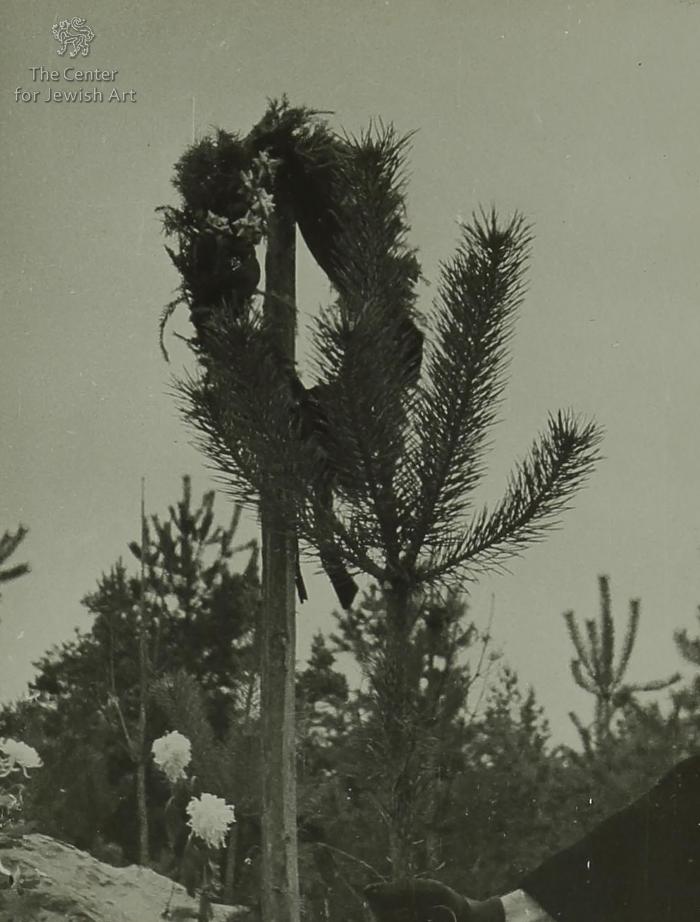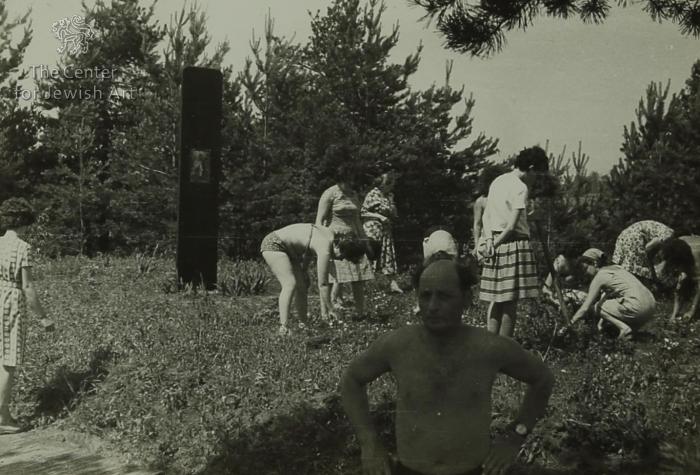Obj. ID: 51836 Old Holocaust memorials in Rumbula near Riga, Latvia, 1962/64

Memorial Name
No official name
Who is Commemorated?
Jews murdered in the Rumbula Forest
Description:
In October 1962, a wooden plaque with the Yiddish inscription was affixed to a pine tree (for the image, see Tseitlin, p. 334 or Meler). This plaque was in place until 1964.
In the next two years, the killing site was further memorialized by a group of activists. They installed a number of objects that included large Magen Davids, a wooden stele with a fragment of the painting "Last Way" by Joseph Kuzkovsky, and a board depicting a Jewish man rising from the grave with his fist clenched (see history).
Inscription
The inscription in Yiddish read:
דא איז פארשטומט
געווארן די שטים
פון 38000 ריג.. ייד..
XI 29-30 XII 9-8 י'-יח' כסלו
Translation: Here the voices of 38,000 Jews of Riga were stilled, November 29-30 [1941] December 8-9 [1941], Kislev 10-18
[In the 1960s, the estimates were that 38,000 Jews were killed at the site]
Commissioned by
Jews of Riga
During two actions, on 30 November and 8 December of 1941, more than 25,000 thousand Jews from the Riga Ghetto were shot in the Rumbula Forest, including approximately 1,000 Jews deported from Germany. In 1944, several hundred men from the Kaiserwald concentration camp were also murdered in Rumbula.
In the spring of 1962, a group of Jewish activists identified the mass graves in the Rumbula Forest. In October 1962, a wooden plaque with the Yiddish inscription was affixed to a pine tree. On November 9, 1962, the activists held the first memorial ceremony at the site. A Magen David made of wooden sticks was placed on one of the graves. Additionally, that same month they made an attempt to receive official permission from the municipal executive committee to commemorate the memories of those murdered in Rumbula but the authorities rejected the application. The activists were well aware that to get a favorable decision they had to have a Jewish ambassador close to party officials, leading to their involvement of Colonel Boris Slutsky to promote their case. Due to Slutsky's influence, the activists indeed received permission to put the site in order on their own. After the legal approval was received many Jews who had previously been afraid to participate in the grass-roots initiative, joined the commemoration project. Dozens of Riga Jews came every Sunday to put the site in order. [Tseitlin, pp. 335-337; Zeltser, pp. 160-161]
The killing site was close to the railroad tracks. The activists marked one of the graves near the railroad with a large Magen David made of barbed wire. It was dismantled multiple times by the authorities. In 1964, on the same spot, a large plywood board with a depiction of a Jewish man rising from the grave with a clenched fist was installed. The figure was close to the tracks so that train passengers could see it. According to most sources, the Jewish man with the fist was painted by Joseph Kuzkovsky, according to another source he was painted by the Riga Jewish activist Mark Blum (Mordechai Lapid). [Tseitlin, pp. 349-350, ills; Alon] This board disturbed the authorities. To pacify them and explain who the figure was threatening, the activists added the inscription "Сurse upon Fascism," but the authorities nonetheless broke the board multiple times.
The memorial site became a place of commemoration not always specifically connected to the events that took place in Rumbula itself. On April 2, 1963, the ceremony was held in Rumbula commemorating the 20th anniversary of the Warsaw Ghetto Uprising. The artist Zalman Baron made a black wooden stele that was installed at the killing site. The back side of the stele had a depiction of red drops of blood in its upper part. In its central part of the stele, a photo showing a central fragment from the drawing "Last Way" was pinned. "Last Way" depicted Jews walking to Babii Yar and was painted by Riga-based Jewish painter Joseph Kuzkovsky in the late 1940s. Currently, the original of "Last Way" is on the permanent display in Knesset. The photograph of the painting that was pinned to the stele was made by Josef Schneider. The ceremony gathered around dozens of people, among them, Frida Mikhelson, a survivor of Rumbula, who publicly told her story.
Architects Nehemia Paul and Isaak Rakhlin compiled a draft of the memorial site. In May 1963, the Latvian Ministry of Culture approved the project of the memorial cemetery in Rumbula. In October 1964, permanent memorial stones were installed at the site. (ID 51809).
Alon (Grinberg), Leia, "Ego poslednee voskhozhdenie," Zametki po evreiskoi istorii 1(124) (January 2010), https://berkovich-zametki.com/2010/Zametki/Nomer1/Alon1.php (accessed September 13, 2023)
Ezergailis, A., The Holocaust in Latvia, 1941-1944: The Missing Center (Riga: The Historical Institute of Latvia; Washington, DC: US Holocaust Memorial Museum, 1996)
For images, see
"Rumbula," Rizhskaia evreiskaia svetskaia shkola, https://skolas.jimdofree.com/война/румбула (accessed September 11, 2023)
For the most detailed history of the memorialzation of the killing site in the Rumbula forest, see
Tseitlin, Shnuel, Dokumental'naia istoriia evreev Rigi (Israel: privately published, 1989)
"Holocaust Memorial Places in Latvia," a website by the Center for Judaic Studies at the University of Latvia
Lenskis, Ilja, Holokausta piemina Latvijā laika gaitā 1945–2015 = Holocaust Commemoration in Latvia in the Course of Time, 1945–2015 (Riga: Muzejs “Ebreju Latvija,” 2017), pp. 85-90.
Meler, Meyer, Jewish Latvia: Sites to Remember (Tel-Aviv: Association of Latvian and Estonian Jews in Israel, 2013)
Zeltser, Arkadi, Unwelcome Memory: Holocaust Monuments in the Soviet Union, trans. A.S. Brown (Jerusalem: Yad Vashem, 2018)



